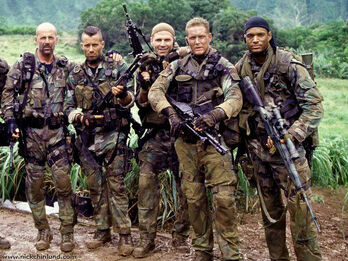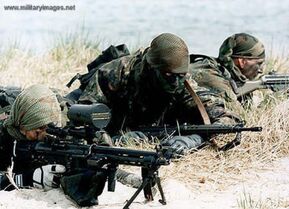Background

Bravo Teams use elements of NG-Tac Armor.
Usually anywhere from a 4 to 15 man squad, a Bravo Team is a cross between U.S. Navy Seals and Delta Force with a focus on Direct Action, Long-Range Reconnaissance Patrol (LRRP) and Long Range Surveillance, Counter-Terrorism, VBSS, high-value target rescue & elimination, Personal Security Detachment, (PSD), and other additional classified Unconventional Warfare methods.
A single Bravo Team can be active in the field with little communication, support, or logistics from Bravo Command for up to one month. Bravo Teams are expected to operate independently from all other Military Commands, commandeer other military units and vessels as they see fit per any Mission Profile they are involved in, and provide all other needed assistance, support, and reinforcement to other military units when requested to do so, all with little oversight from Bravo Command (this is all considered to fall under what is called a Bravo Team Mission or BTM). Bravo Teams are given the greatest independence from all other military units and Military Commands; because of this, critics of the Bravo Team operations often times point to "rogue units" when things don't go as planned.
Because of Bravo Team's classified missions, all units operating with the Office of Defense or OOD fall under the encrypted and secretive Alpha Control Program or ACP, often times refereed to just as Alpha Control; Alpha Control handles all combat and logistical communication for OOD. The nature and scope of ACP is highly classified but, like the OOD, was formed during the Sethas-Po'leks Wars of Aggression.
Design & Beginning

"After Twin Suns, I realized we needed something more. Something more raw."
***General Jason Bravo, reflecting after retirement on the formation of Bravo Team(s) after the Twin Suns Battle***
The first Bravo Team was unofficially formed during the early stages of the deadly one year street-to-street fighting known as the Twin Suns Battle between the Federal 1st Volunteer Army and the Sethas National Army. Formed by then Sergeant Jason Bravo as a means to salvage what remaining troops he could gather from his shattered platoon during a two-week running and hiding firefight between the 1st Brigade of the 1st Division of the Federal 1st Volunteer Army, then Sergeant Bravo led a series of high-risk direct action raids deep into enemy territory night and day. With their own traditional Special Forces units either eliminated or out of range for support, it came down to a group of volunteer militia soldiers with little combat experience and no Special Forces training to perform a series of unthinkable heroic missions on their own accord to try to dislodge enemy forces, ranging from eliminating high level enemy officers to gathering intelligence and taking out enemy tanks with no tank or anti-armor support. From stealing enemy rations and equipment to sabotage of enemy vehicles and equipment, Sergeant Bravo lead roughly 15 soldiers on daring covert missions in those two weeks and engaged in heavy firefights with little to no support on several raids gone wrong.
When the two weeks had ended, Sergeant Bravo's rag-tag survivors of his platoon were known as Bravo's Raiders and decorated numerous times over. Left with little time to celebrate or relax, Bravo was promoted to Second Lieutenant and given a platoon of his own with his original Bravo's Raiders. Personally requesting only the worse tempered and most seasoned soldiers from other units, Bravo started leading similar raids, this time platoon or smaller sized. After a year of fighting in the Twin Suns Battle, the Federals would march onward to the planetary capital in just under 6 months and sack the capital, winning the 2 year campaign over the World of Twin Suns. Nine more years of conflict, some of the bloodiest yet to come, would remain before the end of the Sethas-Po'leks Wars of Aggression.
Officially, the first Bravo Team was formed immediately after the 2 year Twin Suns Campaign with a promotion to Captain for Jason Bravo to lead the team. Still attached to standardized infantry, it would be a long journey for Bravo and his Bravo's Raiders to be accepted by the Special Forces community. It wouldn't be until the Rome Line, 2 years later, that Bravo Team would be accepted and at that, at the heavy and suspicious suggestion and support of the Office of Defense (OOD).
Starting training and organizing of troops and equipment, Bravo---while in the midst of fighting on the front lines---helped form another Bravo Team. Two years later, by the 6th year of the war, the two Bravo Teams were fighting side-by-side with STAT and SNTU Teams, some of the very best the Federal Army had to offer. While other Special Forces units existed---mainly Army Rangers, Marine Force Recon, and Pararescue---all of these other units (with the exception of Pararescue) were disbanded and rolled up into either STAT, SNTU, Bravo Teams, or formed as part of the new Special Operations Brigades (SBOs), which were then henceforth in direct support of STAT and SNTU. In short order, Marine Force Recon would be returned to active status to support growing Fleet operations, but be put under the new title Marine Special Action Force (SAF).
During the bloodiest years of conflict (last 7 years) during the Sethas-Po'leks Wars of Aggression, Bravo Teams---with the core of their existence and training based on Bravo's Raiders---would grow in number from 2 Bravo Teams to 12 Bravo Teams by war's end with the influx of former Army Rangers and the demands of war.
Reputation, Command, Recruitment, Training & Deployment Teams

Bravo Teams gained a reputation for fast, hard-hitting, and durable Special Forces units that often times got the dirty, last-ditch, failure is not an option missions. Many of their missions were out of the box and out of the normal, requiring them to adjust to various mission profiles on the fly and sometimes be performing missions without support, out-numbered, behind enemy lines, and even sometimes in civilian street clothes.
Bravo Teams fell under Bravo Command, which reported directly to Special Forces Command, starting during the Rome Line Campaign. At the end of the Sethas-Po'leks Wars of Aggression, Bravo Command was divided into two different Command Groups: Command Group Red and Command Group Black, all which still reported under Bravo Command. Bravo Command was removed from Special Forces Command and assigned to it's own Command, giving it unheard of independence from standard military command structure. Command Group Black was assigned to Special Forces Command (but still reported to Bravo Command), while Command Group Red was assigned to the Office of Defense (OOD) with only two Bravo Teams attached; the details of the OOD pairing with Bravo Command is highly classified.
Because of their many awards and durable combat record, Bravo Teams have been assigned a special place within Special Forces Recruitment or SFR. The standards are high, but for Bravo Team, the first 4 standards are the most important with everything else "manageable". The first standard is a required 2 years of front-line combat as an infantrymen (at least 3 recorded direct fire engagements) or comparable Special Forces engagements and or at least 2 years of Special Forces service in addition to 2 years as an infantrymen, typically in SBO (peace time requirements were per individual applicant, but still 2 years of infantrymen and 2 years of SBO were still required). The second standard are high weapon skill marks and unconventional tactical thinking. The third standard is a hand written (had to be hand written) and delivered in person recommendation by your Commanding Officer; as Bravo Team saw it, if you were the best, your Commanding Officer thought so too and would go the extra mile for you. Recruits were required to be Sergeants by the time they reached Bravo Team recruitment with high marks put in for Staff Sergeants (most recruits were Staff Sergeants, with very few Sergeants ever selected).
Once recruited, Bravo Team Recruits or BTRs, are put back through a modified month-long Basic Boot Camp and Infantrymen School known as BB or Bravo Basic to refresh and resharpen basic skills. Once BB is passed, which is expected, they move onward to Bravo Team Selection Course or BTSC, a 4 month course intended to give the BTR all the basics for Bravo Team. The regiment is extremely cruel and taxing and of the 30 BTR selected each year, on average, only 5 soldiers will complete the BTSC and move onward to the last stage of training, which is called BST or Bravo Specialized Training, which is training with a Bravo Team for a month before the BFAS or Bravo Final Acceptance Stage, which is a final verbal review and skills test for two days, in which case the remaining BTRs are either accepted or denied into Bravo Team and then assigned to 1 of the 12 Bravo Teams.
Because of their various missions and demands, Bravo Teams are assigned in a rotating on/off shift, with 5 Bravo Teams "on duty" at all times with a sixth on "Ready Active Reserve" stationed on the home planet of Prime and five other Bravo Teams rotated out for break. This cycle runs every 6 months, with the Ready Active Reserve being rotated out monthly. With a foreseeable 7 month deployment with Bravo Team (including the Ready Active Reserve month rotation), all off-duty Bravo Teams are required to serve the remaining 3 months with a SBO or front-line infantry unit assigned by Bravo Command, while the 4th month is assigned to a military unit wherever their family and / or home base is, while their last month is reserved for off-duty/family time.
Deployments include:
- One Team assigned to Presidential Escort Protection or PEP
- One Team assigned to Prime and Home System Deployment or PHSD
- One Team assigned to Mid Rim Operations or MRO
- One Team assigned to Outer Rim Operations or ORO
- One Team assigned to Assignment for Office of Defense or AOOD
- One Team assigned to Ready Active Reserve or RAR